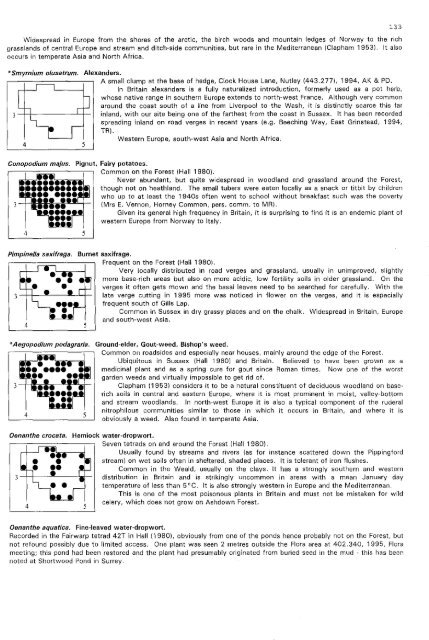Flora of Ashdown Forest - Botanical Society of the British Isles
Flora of Ashdown Forest - Botanical Society of the British Isles
Flora of Ashdown Forest - Botanical Society of the British Isles
Create successful ePaper yourself
Turn your PDF publications into a flip-book with our unique Google optimized e-Paper software.
Widespread in Europe from <strong>the</strong> shores <strong>of</strong> <strong>the</strong> arctic, <strong>the</strong> birch woods and mountain ledges <strong>of</strong> Norway to <strong>the</strong> richgrasslands <strong>of</strong> central Europe and stream and ditch-side communities, but rare in <strong>the</strong> Mediterranean (Clapham 1953). It alsooccurs in temperate Asia and North Africa.*Smyrnium olusatrum. Alexanders.A small clump at <strong>the</strong> base <strong>of</strong> hedge, Clock House Lane, Nutley (443.2771, 1994, AK & PD.In Britain alexanders is a fully naturalized introduction, formerly used as a pot herb,whose native range in sou<strong>the</strong>rn Europe extends to north-west France. Although very commonaround <strong>the</strong> coast south <strong>of</strong> a line from Liverpool to <strong>the</strong> Wash, it is distinctly scarce this far3 inland, with our site being one <strong>of</strong> <strong>the</strong> far<strong>the</strong>st from <strong>the</strong> coast in Sussex, It has been recordedspreading inland on road verges in recent years (e.g. Beeching Way, East Grinstead, 1994,TR).Western Europe, south-west Asia and North Africa.4 5133Gonopodium majus. Pignut, Fairy potatoes.Common on <strong>the</strong> <strong>Forest</strong> (Hall 1980).Never abundant, but quite widespread in woodland and grassland around <strong>the</strong> <strong>Forest</strong>,though not on heathland. The small tubers were eaten locally as a snack or titbit by childrenwho up to at least <strong>the</strong> 19405 <strong>of</strong>ten went to school without breakfast such was <strong>the</strong> poverty3 (Mrs E. Vernon, Horney Common, pers. comm. to MR).Given its general high frequency in Britain, it is surprising to find it is an endemic plant <strong>of</strong>western Europe from Norway to Italy.4 5Pimpinella saxi/raga. Burnet saxifrage.Frequent on <strong>the</strong> <strong>Forest</strong> (Hall 19801.Very locally distributed in road verges and grassland, usually in unimproved, slightlymore base-rich areas but also on more acidic, low fertility soils in older grassland. On <strong>the</strong>verges it <strong>of</strong>ten gets mown and <strong>the</strong> basal leaves need to be searched for carefully. With <strong>the</strong>3 late verge cutting in 1995 more was noticed in flower on <strong>the</strong> verges, and it is especiallyfrequent south <strong>of</strong> Gills Lap.Common in Sussex in dry grassy places and on <strong>the</strong> chalk. Widespread in Britain, Europeand south-west Asia.4 5*Aegopodium podagraria. Ground-elder, Gout-weed, Bishop's weed.Common on roadsides and especially near houses, mainly around <strong>the</strong> edge <strong>of</strong> <strong>the</strong> <strong>Forest</strong>.Ubiquitous in Sussex (Hall 1980) and Britain. Believed to have been grown as amedicinal plant and as a spring cure for gout since Roman times. Now one <strong>of</strong> <strong>the</strong> worstgarden weeds and virtually impossible to get rid <strong>of</strong>.Clapham (1953) considers it to be a natural constituent <strong>of</strong> deciduous woodland on baserichsoils in central and eastern Europe, where it is most prominent in moist, valley-bottomand stream woodlands. In north-west Europe it is also a typical component <strong>of</strong> <strong>the</strong> ruderalnitrophilous communities similar to those in which it occurs in Britain, and where it isobviously a weed. Also found in temperate Asia.Oenan<strong>the</strong> crocata.4Hemlock water-dropwort.Seven tetrads on and around <strong>the</strong> <strong>Forest</strong> (Hall 1980).Usually found by streams and rivers (as for instance scattered down <strong>the</strong> Pippingfordstream) on wet soils <strong>of</strong>ten in sheltered, shaded places, It is tolerant <strong>of</strong> iron flushes.Common in <strong>the</strong> Weald, usually on <strong>the</strong> clays. It has a strongly sou<strong>the</strong>rn and westerndistribution in Britain and is strikingly uncommon in areas with a mean January daytemperature <strong>of</strong> less than 5°C. It is also strongly western in Europe and <strong>the</strong> Mediterranean.This is one <strong>of</strong> <strong>the</strong> most poisonous plants in Britain and must not be mistaken for wildcelery, which does not grow on <strong>Ashdown</strong> <strong>Forest</strong>.5Oenan<strong>the</strong> aquatica. Fine-leaved water-dropwort.Recorded in <strong>the</strong> Fairwarp tetrad 42T in Hall (19801, obviously from one <strong>of</strong> <strong>the</strong> ponds hence probably not on <strong>the</strong> <strong>Forest</strong>, butnot refound possibly due to limited access. One plant was seen 2 metres outside <strong>the</strong> <strong>Flora</strong> area at 402.340, 1995, <strong>Flora</strong>meeting; this pond had been restored and <strong>the</strong> plant had presumably originated from buried seed in <strong>the</strong> mud - this has beennoted at Shortwood Pond in Surrey.
















